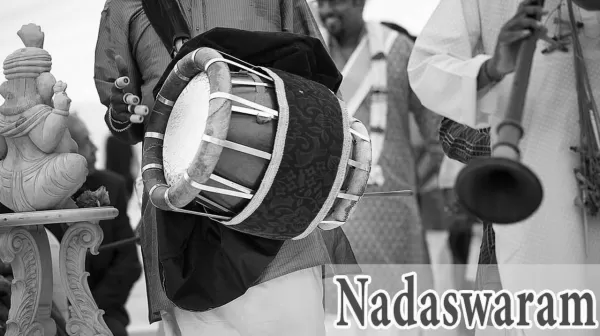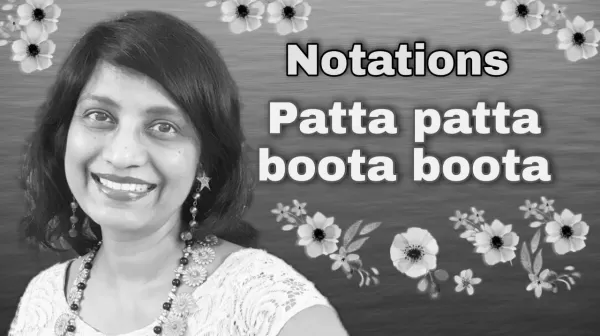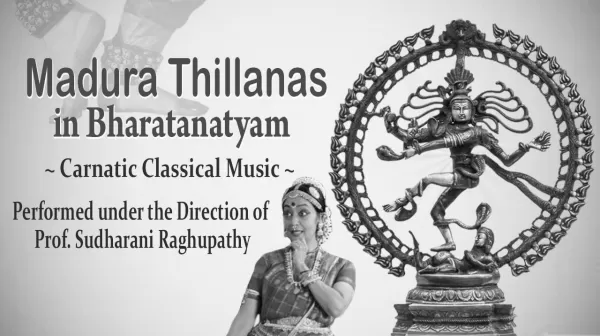राग
MPN Sethuraman & Ponnuswamy ❤️ Nadaswaram & Thavil ❤️ Classical Instrumental ❤️ Western Notes
Nadaswaram, nagaswaram, nadhaswaram or nathaswaram, is a double reed wind instrument. It is a traditional classical instrument originated in Tamil Nadu and also used in Andhra Pradesh, Karnataka, and Kerala (India). This instrument is the world's loudest non-brass acoustic instrument. It is a wind instrument similar to the North Indian shehnai but much longer, with a hardwood body and a large flaring bell made of wood or metal. Thavil or Tavil is a barrel shaped drum from Tamil Nadu. It is used in temple, folk and Carnatic music, often accompanying the nadaswaram.
T.V.Gopalakrishnan ❤️ Classical Instrumental ❤️ Mridangam ❤️ Chappu ❤️ Laya Tharangam
Mridangam is a percussion instrument from India of ancient origin. It is the primary rhythmic accompaniment in a Carnatic music ensemble. The mridangam is also played in Carnatic concerts in countries outside of India, including Sri Lanka, Singapore, Malaysia, Australia, United Kingdom, Canada, and the United States. During a percussion ensemble, the mridangam is often accompanied by the ghatam, kanjira, and the morsing. The mridangam is nicknamed as the "King of Percussion".
E.Gayathri ❤️ Vibrant Veena Instrumental Music ❤️ Jukebox
Listen to Veena Music by E.Gayathri - Vibrant Veena - Classical Music Instrumental Patti Viduva - 00:03 Karpakame - 06:03 Chinnanchiru - 08:34 Mdijese - 13:30 Thillana - 17:22 Emako - 22:58 Eppo Varuvaaro - 27:47 Parama Purusham - 31:49 Narasan Lage - 36:16 Appanna Kondaki - 40:41 Western Waltz - 43:17 Chola Puri - 46:28 Veena is a plucked stringed instrument originating in ancient India, used mainly in Carnatic classical music and Hindustani classical music.
Fusion ❤️ Blend of Sitar & Saxophone ❤️ Thillana ❤️ B.Sivaramakrishna Rao, Janardhan
Sitar is a plucked stringed instrument used mainly in Hindustani music and Indian classical music. The instrument is believed to have been derived from the veena, an ancient Indian instrument, which was modified by a Mughal court musician to conform with the tastes of his Mughal patrons and named after a Persian instrument called the Setar (meaning three strings). In appearance, the Sitar is similar to the Tanpura, except it has frets. The body of Sitar is more or less a spherical gourd at the lower end. Saxophone (also referred to as the sax) is a family of woodwind instruments.
MPN Sethuraman & Ponnuswamy ❤️ Nadaswaram & Thavil ❤️ Classical Instrumental ❤️ Thiruppugazh
Nadaswaram, nagaswaram, nadhaswaram or nathaswaram, is a double reed wind instrument. It is a traditional classical instrument originated in Tamil Nadu and also used in Andhra Pradesh, Karnataka, and Kerala (India). This instrument is the world's loudest non-brass acoustic instrument. It is a wind instrument similar to the North Indian shehnai but much longer, with a hardwood body and a large flaring bell made of wood or metal. Thavil or Tavil is a barrel shaped drum from Tamil Nadu. It is used in temple, folk and Carnatic music, often accompanying the nadaswaram.
T.V.Gopalakrishnan ❤️ Mridangam ❤️ Classical Instrumental ❤️ Laya Tharangam ❤️ Adi Thalam
Mridangam is a percussion instrument from India of ancient origin. It is the primary rhythmic accompaniment in a Carnatic music ensemble. The mridangam is also played in Carnatic concerts in countries outside of India, including Sri Lanka, Singapore, Malaysia, Australia, United Kingdom, Canada, and the United States. During a percussion ensemble, the mridangam is often accompanied by the ghatam, kanjira, and the morsing. The mridangam is nicknamed as the "King of Percussion".
Kadri Gopalnath ❤️ Saxophone ❤️ Classical Instrumental ❤️ Jukebox
Listen to Saxophone (Classical Instrumental Music) by Kadri Gopalnath Naanenu Maadideno - 00:03 Baagilanu Teredu - 06:27 Enu Saadhane Maadi Krishnana - 13:46 Elu Narayanane - 20:45 Elemana Muraayiyanu Kondaado - 28:43:2 Daasa Daasara Maneya - 37:11 Hanumana Mathave - 44:01 Hanthakana Dhootharige - 48:22 Mella Mellane Bandane - 55:08 Saxophone (also referred to as the sax) is a family of woodwind instruments. Saxophones are usually made of brass and played with a single-reed mouthpiece similar to that of the clarinet.
Fusion ❤️ Blend of Sitar and Saxophone ❤️ Mryugnayani ❤️ B.Sivaramakrishna Rao & Janardhan
Sitar is a plucked stringed instrument used mainly in Hindustani music and Indian classical music. The instrument is believed to have been derived from the veena, an ancient Indian instrument, which was modified by a Mughal court musician to conform with the tastes of his Mughal patrons and named after a Persian instrument called the Setar (meaning three strings). In appearance, the Sitar is similar to the Tanpura, except it has frets. The body of Sitar is more or less a spherical gourd at the lower end. Saxophone (also referred to as the sax) is a family of woodwind instruments.
MPN Sethuraman & Ponnuswamy ❤️ Classical Instrumental ❤️ Nadaswaram & Thavil ❤️ Smaravaram Bagudhari
Nadaswaram, nagaswaram, nadhaswaram or nathaswaram, is a double reed wind instrument. It is a traditional classical instrument originated in Tamil Nadu and also used in Andhra Pradesh, Karnataka, and Kerala (India). This instrument is the world's loudest non-brass acoustic instrument. It is a wind instrument similar to the North Indian shehnai but much longer, with a hardwood body and a large flaring bell made of wood or metal. Thavil or Tavil is a barrel shaped drum from Tamil Nadu. It is used in temple, folk and Carnatic music, often accompanying the nadaswaram.
T.V.Gopalakrishnan ❤️ Mridangam ❤️ Classical Instrumental ❤️ Kande Chappu ❤️ Laya Tharangam
Mridangam is a percussion instrument from India of ancient origin. It is the primary rhythmic accompaniment in a Carnatic music ensemble. The mridangam is also played in Carnatic concerts in countries outside of India, including Sri Lanka, Singapore, Malaysia, Australia, United Kingdom, Canada, and the United States. During a percussion ensemble, the mridangam is often accompanied by the ghatam, kanjira, and the morsing. The mridangam is nicknamed as the "King of Percussion".










